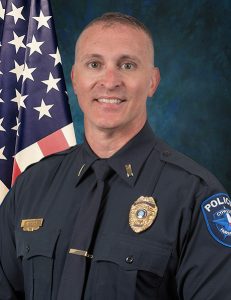Community Policing in Schools by Lt. Shane Wallace
The definition of community policing is a challenging concept to define because there is no single definition that can satisfy all who practice it. The best way to define and describe community policing, in general, is that it is the concept of building relationships and solving problems. Children and teenagers are an important segment of the community that are often overlooked when traditional police departments implement the community policing philosophy. To counteract negative perceptions of police held by children and youths, police departments have programs to foster positive relations with them. Enter the school resource officer (SRO).
School resource officers are sworn law-enforcement officers, with arrest powers, who work either full or part-time in a school setting. SROs wear many hats. They are a law enforcement officer, mentor, informal counselor, teacher, liaison to community resources, and problem solver. With their daily interaction with children and teens, SROs have the best opportunity to engage in community-oriented policing with youth. That daily interaction, and fostering positive relationships, can reduce youth delinquency. Individual schools and campuses should be viewed as a community and not an institution. Likewise, the SRO should be viewed as a member of that community. Many who do not understand the SRO concept feel that an SRO’s presence in schools is seen as the school being unsafe. This is simply not true. The presence of an SRO indicates that positive interaction is being taken to ensure schools are safe and conducive to learning. Research suggests that students’ academic motivation and resistance to problem behaviors depend on their experience of the school as a community (Miller, Hess, Orthmann, 2018). Those experiences must come from parents, school staff, and SROs who will ultimately play an important role in the academic success of students. SROs play a unique role in preserving order and promoting safety on campus which results in better academic success of students.
The SRO’s primary responsibility should be to ensure that his or her campus is safe. A close second is building relationships and problem-solving, aka community-oriented policing. As we stated earlier, community policing involves the concept of building relationships. It takes time to develop trust in a relationship. Time is also an investment that a successful SRO must be willing to make, keeping in mind that a relationship is a process and not an event. An SRO should strive to make time to be visible rather than sitting in an office the entire day. Being visible is important at specific times during the school day. Student arrival, being visible in hallways during class change, lunches, and after-school dismissal are key times when SROs should be visible. In addition to this, an SRO should be present and/or take part in after-school events such as athletic games, theater events, and competitions. This is having “buy-in” within your school and students, even staff, will see your commitment to the campus and the students. It also provides you a perfect opportunity to build relationships with students.
Many SROs seem to not know where to begin when it comes to talking to students. It can start with something as simple as complimenting a team or logo that is displayed on the shirt a student is wearing, telling an athlete “good luck” before a game, or sitting with the student who eats alone at lunch. As you walk past students in the hall, avoid the robot mentality. Don’t be afraid to speak. Simply put, have a personality. As you do this more you will see the students positively respond to you. You will find that they will now be comfortable enough to come and talk to you. They may even give you a nickname. Mine was “O-dub”, which was short for Officer Wallace (the “O” for officer and the “dub” for the W in my last name). Lastly, SROs should get into the classrooms. If time allows it, they should consider doing a classroom presentation at least once a month. There are a variety of topics that can be discussed, from safety to life lessons. Of course, allowing enough time at the end of these presentations for questions and comments is essential.
When it comes to community policing in schools the sky’s the limit. As you foster and build these relationships, you will notice a change in student perception of law enforcement. Crimes and incidents will hopefully decrease. Students who have had discipline issues may not misbehave so much because they do not want to disappoint or let you down. Others will come to you for advice and some may even ask for your help with homework. All of this is because they trust you and because you took the time to invest in them.
References
Miller, L. H. (2018). Community Policing: Partnerships for Problem Solving 8th ed. Boston, MA: Cengage Learning. ❦
 About the Author
About the Author
Professor Shane Wallace has over 25 years of law enforcement experience. He began his law enforcement career in 1998 with the Lee County Sheriff’s Office in his hometown of Giddings, TX, and moved on to the Victoria Police Department.
In 2012, Wallace joined the Cypress-Fairbanks ISD Police Department in Cypress, TX where he holds the rank of lieutenant and oversees numerous agency divisions. In 2019, Professor Wallace became an Adjunct Criminal Justice professor at the University of Houston-Downtown. He has been recognized nationally by receiving the Dick Derzis Safe School Leadership Award in Indianapolis, Indiana. Professor Wallace has also been recognized on the state level as the Regional Director of the Year for the Texas Association of School Resource Officers (TASRO). He is currently the Executive Director for TASRO, representing municipal, county, and school district police officers from the State of Texas.
Wallace holds a Bachelor’s degree in criminal justice from the University of Texas-El Paso and a Master’s degree in criminal justice from Angelo State University.
